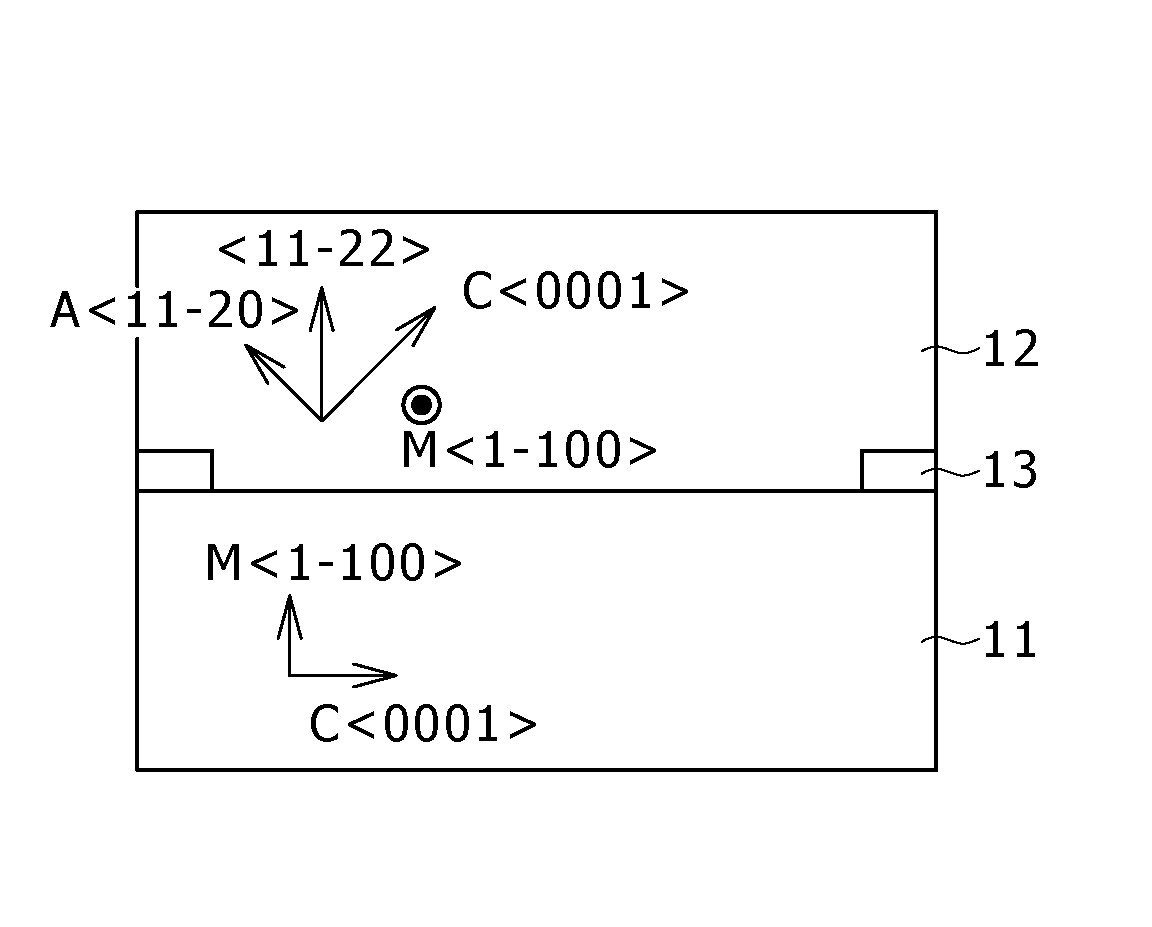Method for growing semiconductor layer, method for producing semiconductor light-emitting element, semiconductor light-emitting element, and electronic device
a technology of light-emitting elements and semiconductors, which is applied in the direction of polycrystalline material growth, crystal growth process, chemically reactive gas, etc., can solve the problems of reducing the probability of electron-hole recombination, reducing the internal quantum efficiency of a light-emitting diode, and reducing the external quantum efficiency. , to achieve the effect of improving crystal quality, reducing piezoelectric field, and improving crystal quality
- Summary
- Abstract
- Description
- Claims
- Application Information
AI Technical Summary
Benefits of technology
Problems solved by technology
Method used
Image
Examples
first embodiment
[0091]the present invention, which is illustrated in FIG. 1, is concerned with a basic method for growing a III-V nitride compound semiconductor layer.
[0092]According to the first embodiment, the sapphire substrate 11, whose principal plane is the (1-100) plane (or M-plane), permits the growth thereon of the III-V nitride compound semiconductor layer 12 having the (11-22) plane direction. The sapphire substrate 11 has the raised parts 13 extending straight in one direction, which have been previously formed thereon from SiO2 or SiN. The sapphire substrate 11 and the III-V nitride compound semiconductor layer 12 have the crystal orientation indicated in FIG. 1. The III-V nitride compound semiconductor layer 12 may be grown by the MOCVD process, for example.
[0093]The III-V nitride compound semiconductor layer 12 in its initial stage of growth is shown in FIG. 2. It grows with its facets orienting in the (11-20) plane (or A-plane), the (0001) plane (or C-plane), and the (11-22) plane. ...
second embodiment
[0103]the present invention, which is illustrated in FIG. 5, is concerned with a basic method for growing a III-V nitride compound semiconductor layer.
[0104]According to the second embodiment, the sapphire substrate 11, whose principal plane is the (1-100) plane (or M-plane), permits the growth thereon of the III-V nitride compound semiconductor layer 12 having the (10-13) plane direction. The sapphire substrate 11 has the raised parts 13 in the same way as in the first embodiment. The sapphire substrate 11 and the III-V nitride compound semiconductor layer 12 have the crystal orientation indicated in FIG. 5. The III-V nitride compound semiconductor layer 12 may be grown by the MOCVD process, for example.
[0105]The III-V nitride compound semiconductor layer 12 in its initial stage of growth is shown in FIG. 6. It grows with its facets facing outward from the (1-100) plane (or M-plane), the (0001) plane (or C-plane), and the (10-13) plane. In this case, its growth in the direction of ...
third embodiment
[0114]the present invention, which is illustrated in FIG. 9, is concerned with a basic method for growing a III-V nitride compound semiconductor layer.
[0115]According to the third embodiment, the sapphire substrate 11, whose principal plane is the (1-102) plane (or R-plane), permits the growth thereon of the III-V nitride compound semiconductor layer 12 having the (11-20) plane direction. The sapphire substrate 11 has the raised parts 13 in the same way as in the first embodiment. The sapphire substrate 11 and the III-V nitride compound semiconductor layer 12 have the crystal orientation indicated in FIG. 9. The III-V nitride compound semiconductor layer 12 may be grown by the MOCVD process, for example.
[0116]The III-V nitride compound semiconductor layer 12 in its initial stage of growth is shown in FIG. 10. In the first example, it grows with its facets facing outward from the (0001) plane (or C-plane) and the (000-1) plane. In the second example, it grows with its facets facing o...
PUM
 Login to View More
Login to View More Abstract
Description
Claims
Application Information
 Login to View More
Login to View More - R&D
- Intellectual Property
- Life Sciences
- Materials
- Tech Scout
- Unparalleled Data Quality
- Higher Quality Content
- 60% Fewer Hallucinations
Browse by: Latest US Patents, China's latest patents, Technical Efficacy Thesaurus, Application Domain, Technology Topic, Popular Technical Reports.
© 2025 PatSnap. All rights reserved.Legal|Privacy policy|Modern Slavery Act Transparency Statement|Sitemap|About US| Contact US: help@patsnap.com



